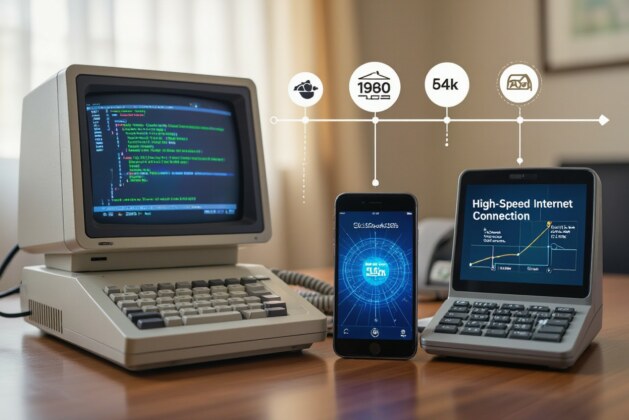Over the decades, I have witnessed how the Internet transformed from a military experiment into a global communication powerhouse. Understanding when the Internet was invented helps you appreciate the remarkable technological breakthroughs and innovations that shaped your daily online experiences. However, alongside its benefits, the Internet also opened doors to new security challenges and vulnerabilities you need to be aware of. In this guide, I will take you through the fascinating milestones that trace the evolution of online connectivity and reveal the true origins of the web we rely on today.
The Birth of Digital Communication
The journey of digital communication began with the ambition to connect computers over a network that could survive potential disruptions. Early experiments in the 1960s laid the groundwork for what would evolve into the modern Internet. I’ve always found it fascinating how this initial effort, spurred by government and academic collaboration, prioritized resilience and flexibility, allowing messages to be broken down into packets and rerouted dynamically. This concept revolutionized how information travels, setting the stage for ubiquitous online connectivity that we now take for granted.
The Role of ARPANET in Shaping Connectivity
ARPANET, launched in 1969 by the U.S. Department of Defense, was the first operational packet-switching network and became the prototype for the Internet. By linking four universities, it demonstrated that computers could communicate across distances using a shared protocol. I often emphasize how ARPANET’s success in enabling resource sharing pushed researchers to expand network capabilities, proving that decentralized networks were not only feasible but also scalable, which directly influenced the Internet’s architecture.
Pioneering Protocols: TCP/IP and Their Impact
TCP/IP protocols, developed in the 1970s by Vint Cerf and Bob Kahn, standardized communication across diverse networks, enabling them to interconnect seamlessly. Their adoption in 1983 as the Internet’s core protocols allowed disparate computer systems to exchange data reliably. This breakthrough transformed isolated networks into a unified global communication platform, laying the structural foundation for everything from email to the World Wide Web today.
Diving deeper into TCP/IP, these protocols introduced modularity by separating the transmission control (TCP) from the internet protocol (IP), thus addressing the complexities of data delivery and routing independently. TCP manages data packet assembly and error-checking, while IP handles addressing and routing—a dual approach that optimizes network performance and resilience. Your ability to access websites or send data across multiple devices without hiccups stems from this elegant protocol design that supports both reliability and scalability.
The World Wide Web: From Concept to Reality
The World Wide Web emerged as a revolutionary layer atop the internet’s existing infrastructure during the late 1980s and early 1990s, transforming how we access and share information. By linking documents through hyperlinks and making content universally accessible, the Web turned the internet into an intuitive, navigable space. This shift unlocked exponential growth in online resources, propelled communication, and laid the foundation for the modern digital ecosystem we engage with daily.
Tim Berners-Lee and the Invention of the Web
Tim Berners-Lee’s 1989 proposal for a system using hypertext to organize and access information sparked the creation of the first web browser and server. By 1991, he launched the initial Web platform at CERN, introducing HTML, URLs, and HTTP—all designed to make documents interlinked and globally reachable. His vision prioritized openness and openness, which allowed the Web to rapidly evolve and become the backbone of online connectivity worldwide.
Browser Evolution: The Key to User Accessibility
Browsers turned the World Wide Web from static code into a dynamic user experience, starting with early versions like Mosaic in 1993, which brought images and text into a graphical interface. Subsequent browsers enhanced speed and security, while innovations such as tabbed browsing, plugins, and integrated search refined how you interact with sites. Every leap in browser technology has widened access and usability, shaping your everyday web adventures.
Following Mosaic’s success, Netscape Navigator quickly became the dominant browser in the mid-1990s, pushing forward features like JavaScript support and cookies that enabled dynamic websites and personalized sessions. Internet Explorer later engaged in the “browser wars,” spurring rapid advancements but also raising concerns over security vulnerabilities. Today, browsers like Chrome and Firefox emphasize speed, compliance with web standards, and privacy controls. This relentless refinement ensures that whether you’re reading, shopping, or collaborating, your browser offers a seamless and secure gateway to the Web’s vast resources.

Bursting the Bubble: The Dot-Com Boom and Bust
The dot-com boom of the late 1990s showcased the explosive growth driven by speculative investments in fledgling internet companies, with NASDAQ tech stocks soaring to unprecedented heights. Yet, by 2000, overvaluations and unsustainable business models led to a sharp market correction, eradicating billions in value. I watched as many startups, once celebrated for rapid expansion despite lacking profits, suddenly vanished. This bust reshaped investor strategies and forced the industry to adopt more realistic approaches to online business viability.
Economic Drivers Behind the Internet Explosion
The arrival of broadband access and the proliferation of personal computers powered a dramatic increase in internet users, sparking demand for innovative online services. Venture capital flowed freely, inflating valuations as companies raced to acquire market share rather than profits. I saw advertising dollars shift online, amplifying visibility for dot-com startups. This convergence of accessible technology, eager investors, and shifting consumer behavior propelled the internet from niche tool to economic powerhouse, creating both opportunity and peril.
Lessons Learned from the Collapse of Dot-Coms
The bust taught me that rapid growth without sustainable revenue is a recipe for disaster. Many companies overpromised and underdelivered, ignoring fundamentals like profitability and realistic market size. Investors began demanding clearer paths to earnings and questioned the value of excessive spending on marketing or infrastructure. This refocus grounded the internet economy, leading to the emergence of companies with robust business models that prioritised long-term stability over quick hype.
Examining the collapse in more detail, I noticed how transparency and due diligence became non-negotiable in assessing internet ventures. Companies that survived had diversified revenue streams and controlled burn rates, avoiding the extravagant valuations disconnected from cash flow. The crash emphasized the importance of adaptability and focus; firms that could pivot sustainably thrived amid the adjustment period. This period redefined internet entrepreneurship and set standards that still influence online business strategies today, underscoring why not all growth is good growth.

Social Media Revolution: Redefining Connectivity
The introduction of social media platforms fundamentally altered how individuals interact, share information, and build communities online. The immediacy and reach of these networks empowered users to connect globally, transcending geographic boundaries like never before. I have observed how platforms evolved from simple communication tools to powerful channels that influence public opinion, commerce, and even political movements, reshaping the fabric of online connectivity in ways the early internet pioneers could scarcely have imagined.
The Rise of Platforms: How Social Networks Connected Us
Starting with platforms like Friendster and MySpace, followed by the explosive growth of Facebook and Twitter, social networks rapidly expanded their user bases, boasting billions worldwide today. These platforms introduced features such as real-time messaging, newsfeeds, and multimedia sharing that created dynamic, interactive experiences. I’ve seen how the viral spread of content on these networks not only connected distant users but also gave rise to new forms of digital culture and community engagement.
Impact on Communication Trends and Cultural Norms
Social media has redefined communication by popularizing instant, public, and multimedia interactions—shifting norms around privacy and conversation. The rise of emojis, memes, and hashtag activism illustrates new digital languages emerging. I notice how these changes encourage brevity and visual storytelling, impacting everything from personal relationships to global social movements and marketing strategies.
Diving deeper, the cultural implications extend beyond everyday communication. For example, platforms like Instagram influenced beauty standards through the proliferation of curated images, while Twitter became a tool for political activism during events such as the Arab Spring. The blurring of public and private spheres challenges traditional notions of identity and expression. Yet, this hyperconnectivity also raises concerns about misinformation, echo chambers, and online harassment, highlighting the need for ongoing critical engagement with how social media shapes societal values and individual behavior.

The Modern Internet: Speed, Access, and Innovation
Over the last two decades, internet speeds have skyrocketed from dial-up’s few kilobits per second to gigabit broadband widely available today. This leap in velocity has transformed everything from streaming high-definition video to real-time online gaming and remote work. Access has also expanded dramatically; efforts like fiber-optic rollouts and global satellite internet projects aim to connect billions still offline. Innovation thrives as technologies such as edge computing and 5G networks reduce latency to mere milliseconds, enabling applications once thought impossible and continuously reshaping how you and I experience online connectivity.
The Transition to Mobile and Cloud Technologies
The shift from stationary desktops to mobile devices revolutionized how we use the internet. Smartphones now account for over 60% of global web traffic, influencing design and development priorities. Complementing mobility, cloud computing has decentralized data storage and processing, offering scalable resources on demand. This transition means you can access your files, applications, and data from anywhere, with services like AWS and Google Cloud powering everything from startups to multinational corporations, making the internet not just faster, but infinitely more flexible.
The Role of AI and IoT in Shaping Future Connectivity
Artificial intelligence and the Internet of Things are converging to redefine connectivity: AI powers data analysis and decision-making, while IoT multiplies the number of connected devices—from smart thermostats to industrial sensors. Together, they generate massive, actionable insights, enhancing everything from energy efficiency in smart cities to personalized user experiences. I see this dynamic expanding rapidly, with AI optimizing network management and IoT devices creating an interconnected web of real-world data streams, driving the next phase of the internet’s evolution.
Diving deeper, AI’s impact extends to improving cybersecurity through predictive analytics, identifying threats before they strike. IoT’s growth—expected to exceed 75 billion devices by 2025—poses unique challenges in bandwidth demand and data management, pushing innovations like 6G and decentralized edge networks. For you, this means smarter home environments, AI-assisted communication, and industrial automation that adapts in real-time. The symbiosis between AI and IoT not only accelerates technological progress but also raises questions about privacy and infrastructure resilience, issues that I believe will dominate future discussions around online connectivity.
Conclusion
Following this overview of the internet’s invention and its ongoing evolution, I hope you grasp how foundational innovations like ARPANET paved the way for today’s global connectivity. As I reflect on this journey from simple data exchanges to the complex networks we use now, I encourage you to appreciate how each advancement has expanded our ability to communicate and share knowledge instantly. Understanding this history helps you see the internet not just as a tool, but as a dynamic system continuously shaping how we interact with the world and each other.





Leave a comment